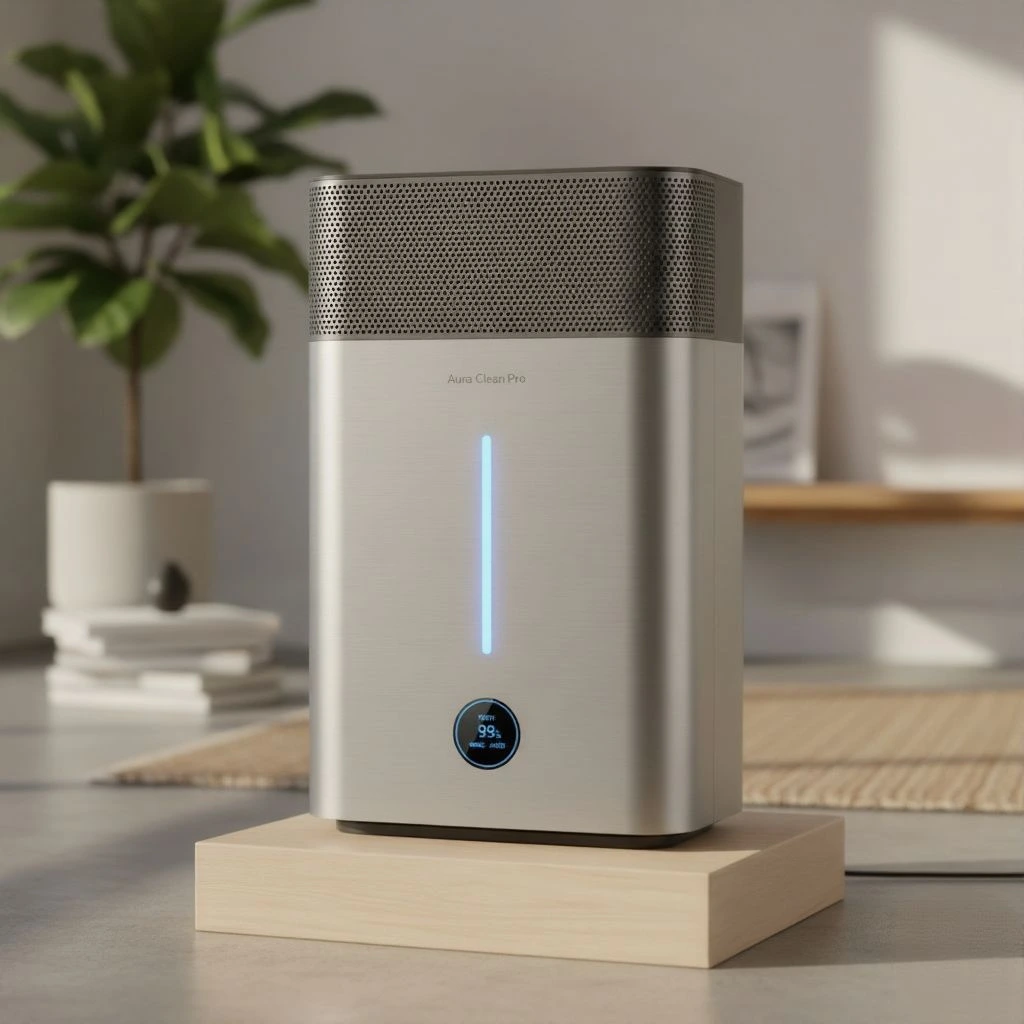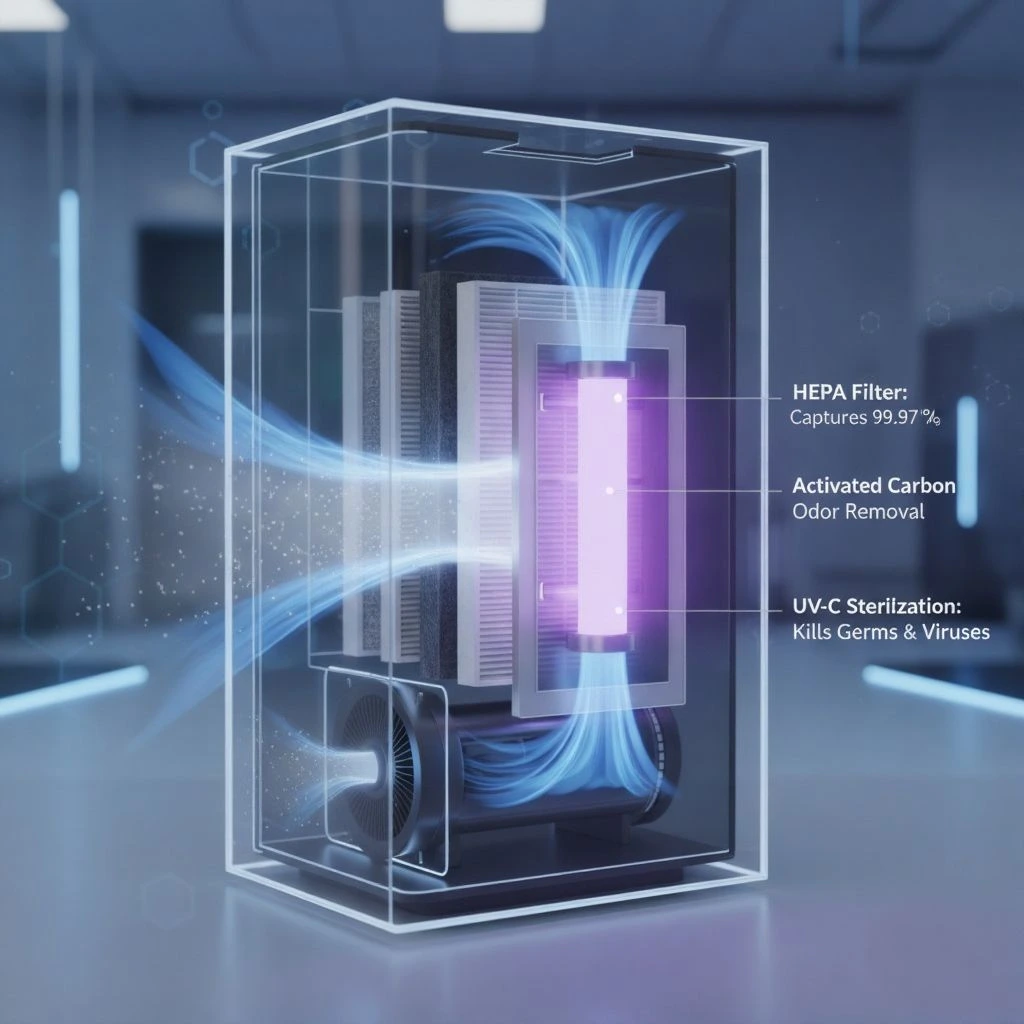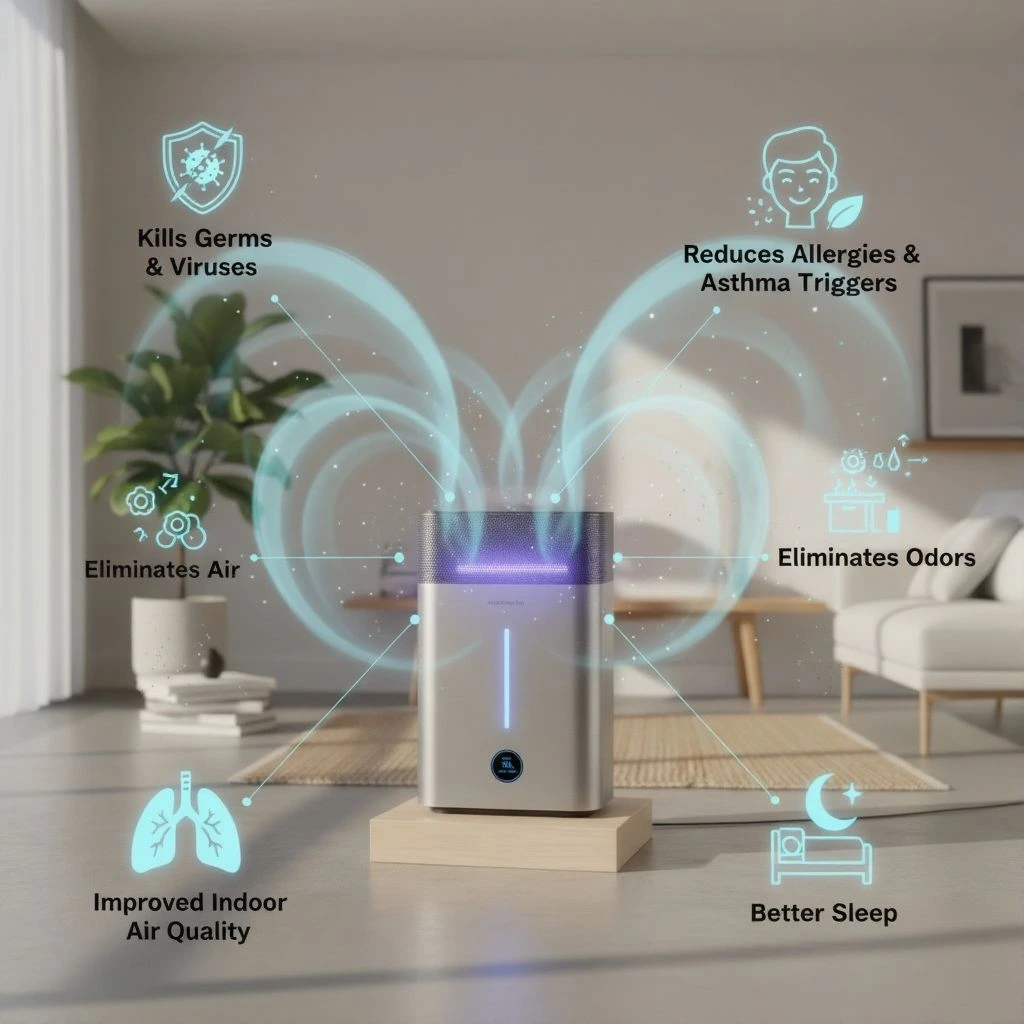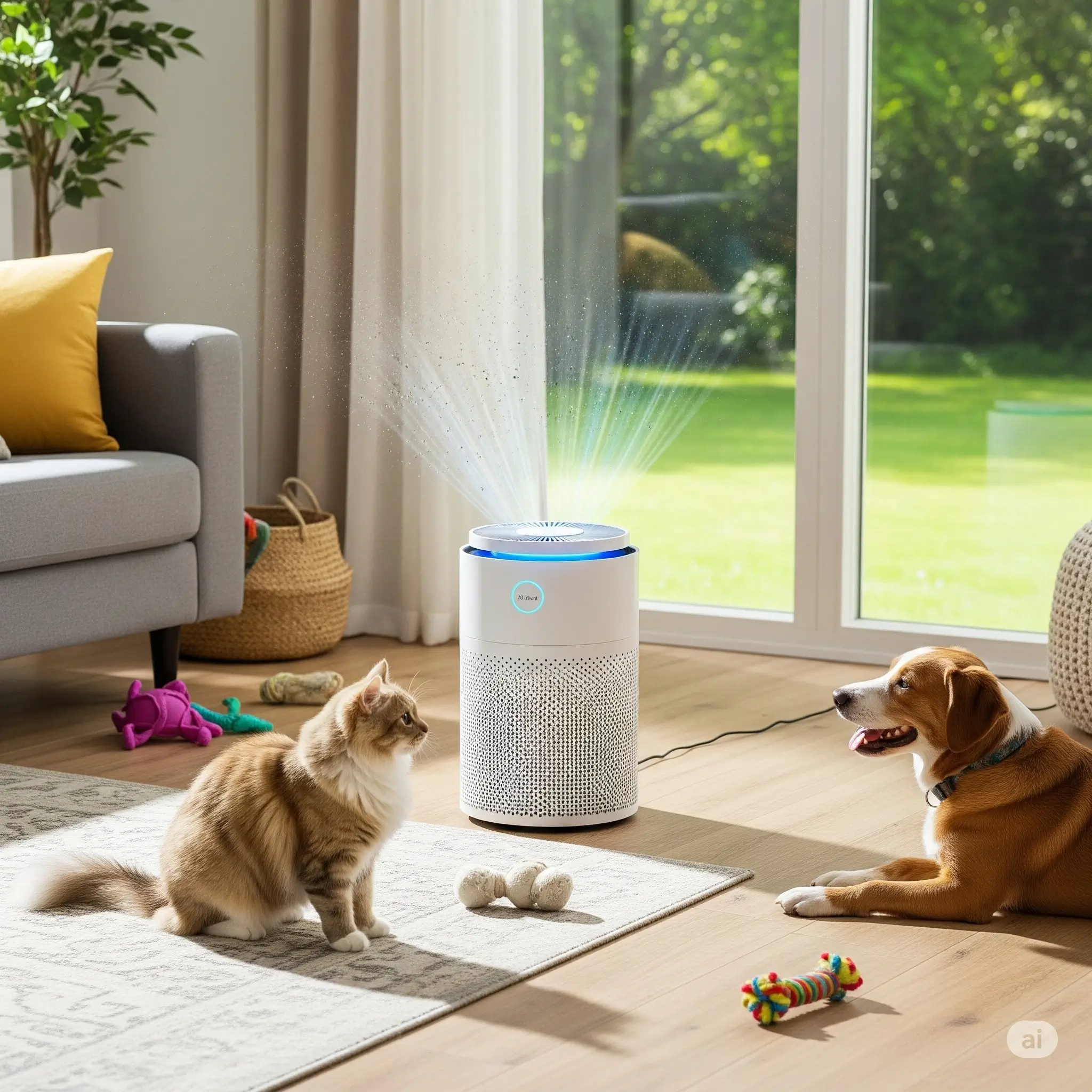
Thinking about getting a uv air purifier? It’s a smart move, especially with all the stuff floating around in the air these days. We spend so much time inside, and honestly, our homes can trap all sorts of things we don’t want to breathe.
This guide is here to break down what these uv air purifier gadgets actually do, what to look for when you’re shopping, and which ones seem to be the best picks for next year. We’ll cover how the UV light works, what other filters you should expect, and why having one might just make your home feel a lot healthier. Let’s get your air cleaner.
Key Takeaways
- UV air purifiers use UV C light to help kill germs like viruses and bacteria that pass through the unit.
- Look for a uv air purifier that also has a HEPA filter and activated carbon to catch particles and odors, not just germs.
- Consider the size of the room the purifier is for and its Clean Air Delivery Rate (CADR) to make sure it’s powerful enough.
- UV bulbs don’t last forever; check how often you’ll need to replace them and how much that costs.
- While UV light helps with germs, it’s just one part of making indoor air cleaner; good filtration is still super important.
Understanding UV Air Purifier Technology
So, you’re looking into UV air purifiers, huh? It’s a pretty interesting bit of tech that’s becoming more common in home air cleaners. Basically, these devices use a special kind of light to zap germs. It’s not magic, but it’s pretty close to it when it comes to tackling tiny, invisible stuff floating around in your air.
How UV-C Light Eliminates Pathogens
At its core, a UV air purifier uses ultraviolet (UV) light, specifically the UV-C spectrum. Think of it like a tiny, contained sunbeam that’s really good at messing with the DNA of microorganisms. When airborne particles like viruses, bacteria, and mold spores pass through the purifier and are exposed to this UV-C light, it damages their genetic material.
This damage prevents them from reproducing and effectively neutralizes them, rendering them harmless. It’s a biological kill switch for germs. The light itself is usually housed within a shielded chamber inside the purifier, so you’re not directly exposed to it. It’s a passive way to deal with microscopic threats that you can’t see but might be breathing in.
The Role of UV in Multi-Stage Filtration
UV-C light isn’t usually the only thing going on in these purifiers. Most of the time, it’s part of a bigger system, a multi-stage filtration setup. You’ll often find it working alongside other filters, like a HEPA filter and an activated carbon filter.
The HEPA filter is the heavy lifter for catching physical particles – dust, pollen, pet dander, that sort of thing. The activated carbon filter is great for grabbing odors and certain gases. The UV-C light then comes in as a sort of final boss, specifically targeting any remaining biological contaminants that might have slipped through or that are too small for even the HEPA filter to catch. It’s like having different security guards, each with a different job, all working together to keep your air clean.
Here’s a quick look at how the stages might work:
- Pre-filter: Catches larger particles like hair and dust bunnies.
- HEPA Filter: Traps 99.97% of particles down to 0.3 microns (think fine dust, pollen, mold spores).
- Activated Carbon Filter: Captures and neutralizes odors, smoke, and harmful volatile organic compounds (VOCs)
- UV-C Light: Neutralizes bacteria, viruses, and mold that may have passed through other filters.

UV-C Effectiveness Against Viruses and Bacteria
When it comes to fighting off viruses and bacteria, UV-C light is pretty effective. Studies have shown that specific doses of UV-C radiation can inactivate a wide range of pathogens. It’s not a magic bullet for every single germ out there, but for many common airborne viruses and bacteria, it does a solid job.
The key is that the light needs enough time and intensity to actually do its work. This is why the design of the purifier mattersand how well the air is exposed to the light. If you’re particularly worried about airborne illnesses spreading in your home, especially during cold and flu season, the UV-C component can offer that extra layer of protection. It’s a way to actively combat the biological threats that other filters might miss.
Key Features to Consider in a UV Air Purifier
When you’re looking at UV air purifiers, it’s not just about the UV light itself. There are several other components and specs that really make a difference in how well the unit works and how convenient it is to use. Think of it like buying a car – you look at the engine, sure, but you also want to know about the seats, the gas mileage, and if it has that cool sunroof.
UV Bulb Configuration and Lifespan
The UV-C bulb is the heart of the germ-killing aspect of these purifiers. You’ll want to check how many bulbs a unit has. Some might have just one, while others pack two for extra power. Also, pay attention to the bulb’s lifespan.
They don’t last forever, and replacing them can be an added cost and hassle. Most bulbs are rated for a certain number of hours, often around 8,000 to 10,000 hours, which translates to a few years of typical use. Some manufacturers might offer longer-lasting bulbs, which is definitely a plus.
HEPA Filtration and Activated Carbon Integration
Most UV air purifiers don’t rely solely on UV light. They usually come with a multi-stage filtration system, and that’s a good thing. A true HEPA filter is pretty standard and is excellent at trapping tiny particles like dust, pollen, and pet dander.
Then, you’ll often find an activated carbon filter. This part is great for tackling smells, like those from cooking or pets, and also helps with certain chemical fumes. The combination of HEPA, carbon, and UV-C light creates a more complete purification process.
Smart Features and Air Quality Sensors
Some of the newer models come with some pretty neat tech. Air quality sensors are becoming more common, and they can automatically adjust the fan speed based on how polluted the air is.
You might also find Wi-Fi connectivity, allowing you to control the purifier with your phone or check air quality reports remotely. While not strictly necessary for purification, these smart features can add a lot of convenience and give you more insight into your home’s air.
Coverage Area and CADR Ratings
This is super important. You need a purifier that’s actually big enough for the room you want to put it in. Manufacturers usually give you a recommended coverage area in square feet. Another key number is the CADR, or Clean Air Delivery Rate.
This tells you how quickly the purifier can clean the air. Higher CADR numbers mean it works faster. A good rule of thumb is to pick a purifier with a CADR that’s at least two-thirds of your room’s square footage. For example, for a 300-square-foot room, aim for a CADR of at least 200.
It’s easy to get caught up in the fancy features, but don’t forget the basics. A purifier that’s too small for your space, even with a UV light, won’t do much good. Make sure the core performance metrics match your room size and your specific air quality concerns.
Benefits of Using a UV Air Purifier
So, you’re thinking about getting a UV air purifier. That’s a smart move if you’re serious about the air you breathe indoors. These units do more than just filter out dust and pollen; they add an extra layer of defense against things you can’t even see.

Enhanced Protection Against Airborne Illnesses
This is where UV air purifiers really shine. The UV-C light works by damaging the DNA of microorganisms like viruses, bacteria, and mold spores. Think of it as a biological sterilizer for your air. When these tiny invaders pass through the purifier and are exposed to the UV-C light, they can no longer reproduce or cause harm.
It’s a proactive way to reduce the spread of germs in your home, especially during cold and flu season or if someone in the household is immunocompromised. It’s not a replacement for good hygiene, of course, but it’s a solid addition to your defense strategy.
Improved Allergy and Asthma Symptom Management
While HEPA filters are great at capturing allergens like pollen, dust mites, and pet dander, UV purifiers can tackle mold spores and certain bacteria that might also trigger allergy or asthma symptoms.
By neutralizing these biological contaminants, UV-C light can contribute to fewer flare-ups and a more comfortable living space for those with respiratory sensitivities. It’s about creating an environment where you can breathe a little easier, day in and day out.
Reduction of Odors and VOCs
Many UV air purifiers also come with activated carbon filters. This combination is pretty effective. The carbon filter grabs onto odor molecules and volatile organic compounds (VOCs), those gassy chemicals that can come from cleaning products, furniture, or even cooking. The UV light then helps break down some of these compounds and also prevents any lingering bacteria that might cause smells from growing. So, you get fresher smelling air, which is always a win.
Creating a Healthier Indoor Environment
Ultimately, the goal is a healthier home. By reducing the load of airborne pathogens, allergens, and odor causing agents, a UV air purifier helps create a more wholesome atmosphere. It’s about peace of mind, knowing you’re taking extra steps to protect your family’s well being.
Investing in a UV air purifier is a step towards a cleaner, safer indoor space. It complements other air cleaning methods by targeting biological contaminants that can impact health and comfort.
Here’s a quick rundown of what UV-C light can help with:
- Neutralizing viruses and bacteria
- Inhibiting mold and mildew growth
- Reducing airborne allergens
- Helping to eliminate odors
Top UV Air Purifier Picks for 2025
Alright, so you’ve decided a UV air purifier is the way to go. That’s smart, especially if you’re worried about germs floating around. But with so many options out there, picking the right one can feel like a puzzle. We’ve sifted through a bunch to give you a head start on finding a model that fits your life.

Overall Performance UV Air Purifier
For a solid all-around performer, the Germ Guardian AC4300 is a strong contender. It’s not the fanciest gadget, but it gets the job done. It can handle spaces up to about 612 square feet, clearing the air in roughly an hour. Its Clean Air Delivery Rate (CADR) is pretty decent, falling between 99 and 116, depending on what kind of particles are in the air.
What’s nice is that it’s not super loud, even when it’s working hard. And if your main concern is zapping viruses and bacteria, this unit does a good job. It’s also not going to break the bank, which is always a plus.
• Pros: Good for medium-sized rooms, effective against pathogens, reasonably priced.
• Cons: Might not be powerful enough for very large areas, energy draw is a bit higher than some.
UV Air Purifier for Allergy Sufferers
If allergies are your nemesis, you’ll want something that tackles those tiny irritants with gusto. While specific models are still being tested for 2025, look for units that combine a robust HEPA filter with UV-C light. The idea is to trap allergens like pollen and dust mites with the filter, and then the UV light can help neutralize any remaining microscopic nasties. Our top recommendation for allergy sufferers is the Austin Air Healthmate.
Keep an eye out for models that boast high CADR ratings for smoke and dust, as these often indicate strong performance against fine particles that trigger allergies. Features like pre-filters to catch larger debris also help extend the life of the main HEPA filter, keeping your allergy relief consistent.
UV Air Purifier for Pet Owners
Living with pets is great, but the odors and dander? Not so much. For pet owners, a UV air purifier with a strong activated carbon filter is key. This type of filter is specifically designed to absorb odors, so that lingering.Check out the Blue Air Blue Pure 211i Max
Choosing the Right UV Air Purifier for Your Needs
So, you’ve decided a UV air purifier is the way to go. That’s great! But with so many options out there, how do you pick the one that’s actually going to work for your home? It can feel a bit overwhelming, I get it. Let’s break it down.
Assessing Your Home’s Specific Air Quality Challenges
First off, what’s actually bothering you about your indoor air? Are you dealing with a lot of dust bunnies that seem to multiply overnight? Maybe your furry friends leave behind more than just cuddles – think dander and those distinct pet odors.
Or perhaps someone in the house has allergies or asthma, and you’re looking for some relief from sneezing fits and wheezing. Knowing your main problem helps a ton. For instance, if pet odors are a big issue, you’ll want a unit with a really good activated carbon filter.
If it’s mostly about tiny particles like pollen or dust, then a strong HEPA filter is your best bet. UV light is fantastic for germs, but it doesn’t really do much for smells or larger particles on its own. It’s usually part of a bigger system.
Understanding Maintenance Requirements
No one likes surprises, especially when it comes to upkeep. Most UV air purifiers will need regular filter changes. This is pretty standard for any air purifier, really. You’ll want to check how often the filters need replacing – some might last 6 months, others a year. And don’t forget the UV bulb itself. These bulbs don’t last forever; they typically need replacing every 1-3 years, depending on the model.
Some units will even have a little indicator light to let you know when it’s time. It’s worth looking into the cost of replacement filters and bulbs too, so you know what you’re getting into long-term. It’s not just about the initial purchase price; ongoing costs matter.
Balancing Performance, Features, and Budget
This is where you have to make some choices. Do you need the absolute top-of-the-line model with all the bells and whistles, or will a more basic unit do the trick? Think about the size of the room you want to purify.
A small bedroom needs a different kind of machine than a large, open-plan living area. Check the CADR (Clean Air Delivery Rate) ratings – higher numbers mean it cleans the air faster. Smart features, like app control or air quality sensors, are nice to have, but they do add to the cost. You really need to figure out what features are non-negotiable for you and what you can live without.
If your budget is tight, you might have to compromise on some of the fancier features, but don’t skimp on the core purification power.
It’s all about finding that sweet spot that fits your needs and your wallet. For a good starting point on what to look for, check out this guide to choosing an air purifier.
Remember, the goal is cleaner air for your home. While fancy features are appealing, focus on the purification capabilities first. A unit that effectively removes the pollutants bothering you is more important than one that can tell you the weather.
Wrapping Up Your Quest for Cleaner Air
So, we’ve gone through a lot of information about UV air purifiers, looking at what makes them tick and what to watch out for. It’s clear that these gadgets can really help clear the air in your home, especially if you’re dealing with allergies, pets, or just want that extra peace of mind against germs.
Finding the right one means thinking about your specific needs – like room size, noise level, and, of course, your budget. Don’t just grab the first one you see; take a moment to compare the features and see which model truly fits your life. Investing in a good air purifier is a solid step towards a healthier, more comfortable living space for you and your family. Here’s to breathing easier!
Frequently Asked Questions
What exactly is a UV air purifier and how does it work?
Think of a UV air purifier as a special kind of air cleaner that uses a UV-C light bulb. This light is like a tiny germ killer. As dirty air passes through the purifier, the UV-C light shines on it, zapping tiny things like viruses, bacteria, and mold so they can’t make you sick. It’s an extra step to make your air super clean.
Is UV light in air purifiers safe for people and pets?
Yes, the UV-C light in these purifiers is generally safe. The light is usually contained within the unit, so you don’t come into direct contact with it. It’s designed to work its magic on the air inside the machine, not on you or your furry friends.
How often do I need to change the UV bulb?
UV bulbs don’t last forever, but they usually stick around for a good while – often a year or more with regular use. Many purifiers will let you know when it’s time for a new bulb, or you can check the manufacturer’s instructions. It’s important to replace it to keep the germ-killing power strong.
Can a UV air purifier get rid of all types of germs?
UV-C light is really good at tackling many common germs like viruses and bacteria. However, it might not get absolutely everything, especially if the germs are only exposed for a very short time. That’s why many UV air purifiers also have other filters, like HEPA, to catch even more tiny particles.
Do UV air purifiers help with allergies or asthma?
Absolutely! While the UV light focuses on germs, the other filters in the purifier, like HEPA filters, are excellent at trapping allergy triggers such as pollen, dust mites, and pet dander. By removing these, UV air purifiers can help make breathing easier for people with allergies or asthma.
Are UV air purifiers more expensive than regular air purifiers?
Sometimes, units with UV-C light technology can cost a bit more upfront than basic models. However, the added protection against germs can be well worth the investment, especially if you’re concerned about staying healthy. Keep in mind you’ll also need to factor in the cost of replacement UV bulbs over time.


